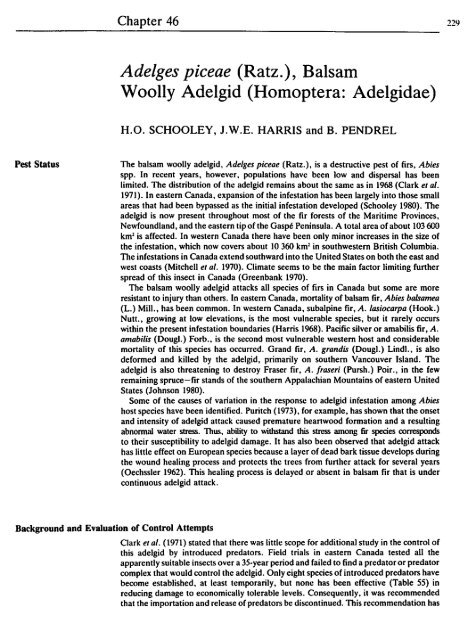pdf, 57.71Mb - Entomological Society of Canada
pdf, 57.71Mb - Entomological Society of Canada
pdf, 57.71Mb - Entomological Society of Canada
Create successful ePaper yourself
Turn your PDF publications into a flip-book with our unique Google optimized e-Paper software.
Pest Status<br />
Chapter 46<br />
Background and Evaluation <strong>of</strong> Control Attempts<br />
Adelges piceae (Ratz.), Balsam<br />
Woolly Adelgid (Homoptera: Adelgidae)<br />
H.O. SCHOOLEY, l.W.E. HARRIS and B. PENDREL<br />
The balsam woolly adelgid, AdeJges piceae (Ratz.), is a destructive pest <strong>of</strong> firs, Abies<br />
spp. In recent years, however, populations have been low and dispersal has been<br />
limited. The distribution <strong>of</strong> the adelgid remains about the same as in 1968 (Clark el al.<br />
1971). In eastern <strong>Canada</strong>, expansion <strong>of</strong> the infestation has been largely into those small<br />
areas that had been bypassed as the initial infestation developed (Schooley 1980). The<br />
adelgid is now present throughout most <strong>of</strong> the fir forests <strong>of</strong> the Maritime Provinces,<br />
Newfoundland, and the eastern tip <strong>of</strong> the Gaspe Peninsula. A total area <strong>of</strong> about 103600<br />
kml is affected. In western <strong>Canada</strong> there have been only minor increases in the size <strong>of</strong><br />
the infestation, which now covers about 10 360 kml in southwestern British Columbia.<br />
The infestations in <strong>Canada</strong> extend southward into the United States on both the east and<br />
west coasts (Mitchell el al. 1970). Climate seems to be the main factor limiting further<br />
spread <strong>of</strong> this insect in <strong>Canada</strong> (Greenbank 1970).<br />
The balsam woolly adelgid attacks all species <strong>of</strong> firs in <strong>Canada</strong> but some are more<br />
resistant to injury than others. In eastern <strong>Canada</strong>, mortality <strong>of</strong> balsam fir, Abies balsamea<br />
(L.) Mill., has been common. In western <strong>Canada</strong>, subalpine fir, A. Jasiocarpa (Hook.)<br />
Nutt., growing at low elevations, is the most vulnerable species, but it rarely occurs<br />
within the present infestation boundaries (Harris 1968). Pacific silver or amabilis fir, A.<br />
amabilis (Doug!.) Forb., is the second most vulnerable western host and considerable<br />
mortality <strong>of</strong> this species has occurred. Grand fir, A. grandis (Doug!.) Lind!', is also<br />
deformed and killed by the adelgid, primarily on southern Vancouver Island. The<br />
adelgid is also threatening to destroy Fraser fir, A. fraseri (Pursh.) Poir., in the few<br />
remaining spruce-fir stands <strong>of</strong> the southern Appalachian Mountains <strong>of</strong> eastern United<br />
States (Johnson 1980).<br />
Some <strong>of</strong> the causes <strong>of</strong> variation in the response to adelgid infestation among Abies<br />
host species have been identified. Puritch (1973), for example, has shown that the onset<br />
and intensity <strong>of</strong> adelgid attack caused premature heartwood formation and a resulting<br />
abnormal water stress. Thus, ability to withstand this stress among fir species corresponds<br />
to their susceptibility to adelgid damage. It has also been observed that adelgid attack<br />
has little effect on European species because a layer <strong>of</strong> dead bark tissue develops during<br />
the wound healing process and protects the trees from further attack for several years<br />
(Oechssler 1962). This healing process is delayed or absent in balsam fir that is under<br />
continuous adelgid attack.<br />
Clark et al. (1971) stated that there was little scope for additional study in the control <strong>of</strong><br />
this adelgid by introduced predators. Field trials in eastern <strong>Canada</strong> tested all the<br />
apparently suitable insects over a 35-year period and failed to find a predator or predator<br />
complex that would control the adelgid. Only eight species <strong>of</strong> introduced predators have<br />
become established, at least temporarily, but none has been effective (Table 55) in<br />
reducing damage to economically tolerable levels. Consequently, it was recommended<br />
that the importation and release <strong>of</strong> predators be discontinued. This recommendation has<br />
229
















